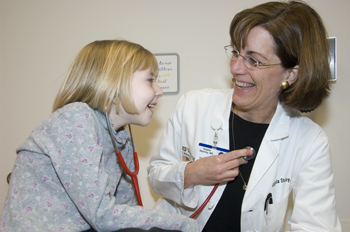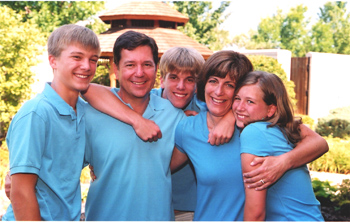Although she always knew she wanted to be a physician, Angela M. Sharkey, M.D., found her specialty in the first month of her pediatric residency at Cardinal Glennon Children’s Hospital.
While working in the neonatal intensive care unit, she was deeply affected by three babies born with hypoplastic left heart syndrome, a fatal defect in which the left side of the heart is underdeveloped.

“I was having discussions with the families and telling them that their children would not survive, and I thought it would have been easier for them to cope if they’d known prior to birth that their children would have this lethal problem,” said Sharkey, associate professor of pediatrics and a pediatric cardiologist at St. Louis Children’s Hospital.
About that same time, an article about using ultrasound to diagnose congenital heart disease prenatally was published. After reading it, Sharkey felt compelled to focus her career on helping these children. She completed a fellowship at The Children’s Hospital of Philadelphia under James Huhta, M.D., who is world-renowned for the prenatal diagnosis of congenital heart disease, and William Norwood, M.D., a groundbreaking cardiothoracic surgeon.
Sharkey was recruited to the School of Medicine and St. Louis Children’s Hospital in 1992 to start a fetal echocardiography program. In 2006, the clinic’s team performed more than 800 fetal echocardiograms, in which ultrasound is used to examine the heart of the baby still in the womb.
“When Angela was being recruited, I was excited at the prospect of working with a pediatric cardiologist who was actually trained to interpret a fetal echocardiogram in real time,” said Diana L. Gray, M.D., professor of obstetrics and gynecology and of radiology. “In the intervening years, I have often worked side by side with Angela performing fetal echocardiograms in our prenatal ultrasound units. I value her expertise and her friendship at work and in leisure time.”
Sharkey sees expectant mothers at about 20 weeks’ gestation upon referral from obstetricians, who may have seen something abnormal on a routine ultrasound.
“We start a relationship with the family at the time of diagnosis and see them every 4-6 weeks,” Sharkey said. “By the time the baby arrives, the family has already seen the cardiac intensive care unit and the newborn nursery. They have talked with surgeons about what issues might arise after the baby is born and with neonatologists about delivery-room management.”
Sharkey also directs the Marfan syndrome clinic at St. Louis Children’s Hospital. She became interested in Marfan when she first arrived at the University and treated patients who had the disease.
“Through that work, I got to know some of the families and began following more and more patients with Marfan,” she said. “Because those patients require care from several subspecialty physicians, it just seemed logical to have a more organized structure for those patients.”
Modeled after the adult Marfan syndrome clinic at Barnes-Jewish Hospital headed by Alan C. Braverman, M.D., professor of medicine, the clinic allows patients to see all of their specialists in one visit to the hospital. Her clinic’s reputation is so strong that Sharkey was approached by the Pediatric Heart Network to participate in a multicenter clinical trial of a drug that has been shown in mice to prevent the development of aortic aneurysm, a dangerous effect of Marfan syndrome. So far, St. Louis Children’s Hospital has the third-largest number of patients enrolled in the trial.

Sharkey also researches childhood obesity and its effects on the heart. She and a colleague recently found that children who are obese or who are at risk for obesity show early signs of heart disease similar to obese adults with heart disease. Those findings could help determine whether physicians could intervene to ward off heart disease in these children.
Developing students and faculty
But patient care and research are just two of Sharkey’s many activities. In 1996, Alan L. Schwartz, Ph.D., M.D., the Harriet B. Spoehrer Professor and head of the Department of Pediatrics, asked Sharkey to share the responsibility of coursemaster of the pediatric clerkship for third-year medical students. In that role, she oversees 120 students each year.
In addition, she advises students interested in a career in pediatrics, mentors female students and oversees the pediatric rotations, subinternships and rural clerkships for fourth-year medical students.
In recognition of her teaching prowess, Sharkey received the Outstanding Teacher Award from the Department of Pediatrics and St. Louis Children’s Hospital in 1999 and the Samuel L. Goldstein Leadership Award in Medical Student Education from the School of Medicine in 2001.
It was through her involvement with medical student education that she became involved with the Council on Medical Student Education in Pediatrics (COMSEP), a national organization for clerkship directors in pediatrics. She joined a task force on faculty development and ultimately was asked to co-chair that task force. Shortly after, she was asked to start and lead an Office of Faculty Development within the Department of Pediatrics at the School of Medicine. In this role, she also works closely with Gray, also associate dean for faculty affairs, to jointly sponsor faculty programs.
“The pediatrics department has begun to focus on issues of retention and promotion of faculty within the department, and we’ve also tried to raise awareness of the need to focus on the unique challenges that women face in academic careers,” said Sharkey, who is an active member of the University’s Academic Women’s Network.
To address some of those challenges, the Office of Faculty Development has established networking and mentoring opportunities for both male and female junior pediatrics faculty, established a lactation facility in the office tower at St. Louis Children’s Hospital, teamed with the School of Medicine to sponsor a symposium for women faculty to present their research and presented a proposal for a backup child-care and elder-care program for medical center faculty and staff.
|
Angela Sharkey
Hometown:Decatur, Ill. Education:B.A., 1982, Creighton University; M.D., 1986, Saint Louis University Family: Husband Gerry Lauber; children Chris, 16; John, 14; and Samantha, 12 Family tree: Sharkey’s father and father-in-law are retired family practitioners, and her grandfather was a surgeon for the railroad. Hobbies: Traveling, skiing, snorkeling, playing golf, fly-fishing, hiking and reading Currently reading: “The Inheritance of Loss” |
“Angela Sharkey is a real, yet non-classical, triple-threat faculty colleague,” Schwartz said. “She is a superior clinician, revered by her patients and families; she is an educational leader, now 12 years as co-coursemaster of the third-year pediatrics clerkship; and most recently a capable administrator and faculty leader in her role as director of the Office of Faculty Development.”
“As a champion of faculty development in the Department of Pediatrics, she is the architect of new infrastructure and expectations that optimize each faculty member’s trajectory toward academic success,” said F. Sessions Cole, M.D., the Park J. White, M.D., Professor of Pediatrics and assistant vice chancellor for children’s health.
Sharkey credits her husband, Gerry Lauber, with backing her career. “My husband has been very supportive, helping to raise the kids and doing the cooking,” she said. “I wouldn’t have been as successful without him.”
Lauber teaches math at Crossroads College Preparatory School. They have three children: Chris, 16; John, 14; and Samantha, 12. Sharkey said her children have always encouraged her, knowing she cares for sick babies.
Rhythm of the heart
As her children have gotten older, they have become involved with her in a project that makes Sharkey’s face light up: Camp Rhythm, a week-long summer camp for children with congenital heart disease. Sharkey co-founded the camp in 2004 with colleagues in the cardiac unit at St. Louis Children’s Hospital after a patient was turned away from a summer camp because he required medicine several times a day.
Supported by the St. Louis Children’s Hospital Foundation and Friends of St. Louis Children’s Hospital, Camp Rhythm at Babler State Park offers up to 60 campers who have congenital heart disease with “normal kid activities,” Sharkey said, such as swimming, archery, kickball and campfires, but also the administration of medications several times a day.
“We have more than 20 counselors, a physician, a nurse and child-life specialist spending the week there,” said Sharkey, who also staffs the camp. Her son Chris is a counselor, and her mother-in-law, Sue Lauber-Fleming, assists with a day camp for younger children. Her husband and two other children help out with fishing activities.
“A lot of the campers are kids I diagnosed with congenital heart disease before they were born, so I’ve known their families for a long time,” Sharkey said.
The campers are not the only ones who have a life-changing experience, Sharkey said.
“My family sees how happy this makes me,” she said.